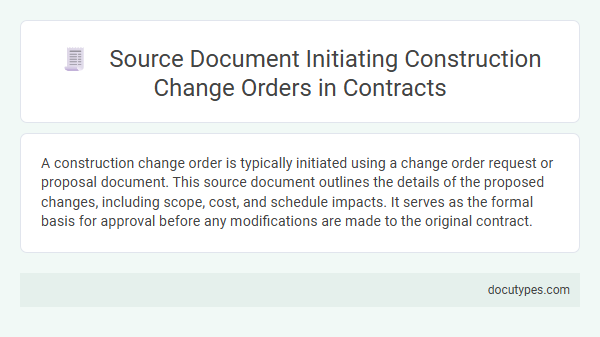A construction change order is typically initiated using a change order request or proposal document. This source document outlines the details of the proposed changes, including scope, cost, and schedule impacts. It serves as the formal basis for approval before any modifications are made to the original contract.
Introduction to Construction Change Orders
Construction change orders are formal amendments to the original contract that modify the scope, cost, or schedule of a construction project. They ensure all parties agree to adjustments and maintain project continuity.
The source document used to initiate a construction change order is typically a written change directive or request for change submitted by the contractor or owner. This document outlines the proposed modification and serves as the basis for formal approval and adjustment of contract terms.
Importance of Source Documents in Change Order Initiation
Source documents are essential for initiating construction change orders as they provide the foundational details and authorization needed to modify contract terms. Accurate source documents ensure transparency and accountability throughout the change order process.
- Contract Drawings - These provide the original design specifications that help identify necessary modifications.
- Change Request Forms - Formal documents submitted by contractors or clients to propose alterations to the scope of work.
- Field Reports - On-site records that capture conditions or issues requiring adjustments to the contract.
Common Types of Source Documents for Change Orders
Source documents are essential for initiating a construction change order as they provide the basis and authorization for modifications. These documents ensure that changes are accurately tracked and communicated between all parties involved in the project.
Common types of source documents for construction change orders include change request forms, which are submitted by contractors or clients to propose alterations. Drawing revisions serve as another critical source, detailing adjustments to the original design or specifications. Additionally, field reports and meeting minutes often act as official records that justify change orders based on on-site conditions or stakeholder decisions.
Role of Contracts in Managing Change Orders
A construction change order is initiated using a specific source document that outlines the modifications requested. Contracts play a crucial role in managing these change orders by defining the procedures and approvals required.
- Request for Change Document - This document formally initiates the change order by detailing the scope, cost, and time impacts of the proposed adjustment.
- Contract Clauses on Change Orders - Contract provisions specify how changes must be submitted, reviewed, and approved to maintain project control and legal compliance.
- Change Order Approval Process - The contract establishes the roles and responsibilities of parties involved in evaluating and authorizing change orders to ensure transparency and accountability.
Key Elements of a Valid Source Document
| What Source Document Is Used to Initiate a Construction Change Order? Key Elements of a Valid Source Document | |
|---|---|
| Source Document Types |
|
| Key Elements of a Valid Source Document |
|
| Purpose of Source Document | Acts as the formal basis to initiate, document, and authorize a construction change order, ensuring transparency and contractual compliance. |
Standard Procedures for Submitting Source Documents
The primary source document used to initiate a construction change order is the Change Order Request (COR) form. Standard procedures for submitting this document require detailed descriptions of the proposed changes, including cost and schedule impacts. Contractors must submit the COR to the project manager for review and approval before implementation begins.
Verification and Approval Processes
A construction change order begins with a source document, typically a Change Request Form or a Request for Information (RFI). This document details the proposed modifications, including scope adjustments, cost implications, and scheduling impacts.
The verification process involves reviewing the source document against project specifications and contract terms to ensure accuracy and feasibility. Your approval is essential before the change order is formally issued, guaranteeing all stakeholders agree on the revised contract conditions.
Potential Risks of Inadequate Documentation
The source document used to initiate a construction change order is typically a detailed Change Order Request (COR) or a Construction Change Directive. This document outlines the scope, cost, and schedule impacts of the proposed change. Inadequate documentation of these changes can lead to disputes, cost overruns, and project delays, posing significant risks to all parties involved.
Best Practices for Documenting Construction Changes
The source document used to initiate a construction change order is typically the Change Order Request (COR), which outlines the proposed modifications and their implications. Proper documentation of construction changes is crucial to ensure clarity, accountability, and alignment among all stakeholders involved in the project.
- Clear Identification - Each change order must include precise details about the scope, cost, and timeline impact to avoid disputes.
- Consistent Use of Forms - Standardized templates for change orders help maintain uniformity and streamline the approval process.
- Comprehensive Record Keeping - Documenting all communications and approvals related to changes safeguards project integrity and provides traceability.
Following these best practices empowers you to manage construction changes effectively and minimize project risks.
What Source Document Is Used to Initiate a Construction Change Order? Infographic

